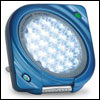 Major depressive disorder in elderly individuals is prevalent and debilitating.
Major depressive disorder in elderly individuals is prevalent and debilitating.
Researchers from the Netherlands measured the response to bright light therapy (BLT) in elderly patients with major depressive disorder.
First, the details.
- 89 elderly people with major depressive disorder were assigned to a treatment group for 3 weeks.
- 1-hour early-morning BLT (pale blue, approximately 7500 lux)
- Placebo (dim red light, approximately 50 lux)
- Improvement in the Hamilton Scale for Depression scores was measured at the end of treatment and 3 weeks later.
- Sleep response and cortisol and melatonin levels were also measured.
- Melatonin helps maintain the body’s circadian rhythm.
And, the results.
- Depression improved significantly more with BLT vs placebo at the end of treatment and 3 weeks later.
- At the end of treatment:
- Get-up time after final awakening, sleep efficiency, and the steepness of the rise in evening melatonin levels improved significantly more with BLT vs placebo.
- At 3 weeks after completion of BLT:
- Get-up time was still significantly improved in with BLT compared to the start of the study.
- 24-hour urinary free cortisol level was significantly 37% lower vs placebo.
- Evening salivary cortisol level decreased a significant 34% in the BLT group vs an increase of 7% with placebo.
The bottom line?
The authors concluded, “In elderly patients with major depressive disorder, BLT improved mood, enhanced sleep efficiency, and increased the upslope melatonin level gradient.”
There was also improvement in mood and an attenuation of cortisol hyperexcretion after discontinuation of treatment.
A PubMed search failed to reveal other studies in elderly people with major depressive disorder.
1/23/11 19:09 JR